MS Storage Clean-Up Campaign: Frequently Asked Questions (FAQs)
What is the MS Storage Clean-Up Campaign
It is an initiative by NWU to help staff and students manage their storage usage within Microsoft 365 applications such as OneDrive, MS-Teams (SharePoint), and Outlook by deleting unnecessary files and staying within newly enforced storage limits.
Why did Microsoft implement the new pooled storage policy in 2023?
Microsoft introduced this policy to minimize security risks from legacy storage and data sprawl. Education and research sectors, particularly K-12 schools, are prime targets for malware attacks. Additionally, it aims to reduce the global carbon footprint caused by "dark data," which contributes to excess electricity consumption.
How does the pooled storage policy affect me?
All MS 365 applications contribute to NWU’s pooled storage, meaning both staff and students must adhere to the storage quotas allocated for each service OneDrive, MS-Teams (SharePoint), and Outlook).
What are the storage limits?
| Staff | 30 GB on OneDrive, 10 GB for Outlook, and 100 GB for archives. |
| Postgraduate (M&D) Students | 10 GB on OneDrive, 5 GB for Outlook. |
| Undergrad Students | 0 GB on OneDrive, 1 GB for Outlook. |
| MS SharePoint/MS Teams Sites | 10 GB |
| Shared Mailboxes | 10 GB |
Why is it important to clean up my storage now?
With the new pooled storage policy in place, excessive storage usage could lead to reduced performance and higher security risks. Cleaning up your storage ensures you stay within the storage quotas and helps minimize unnecessary energy consumption, aligning with NWU’s and Microsoft’s sustainability goals.
What are the best practices for managing my storage?
Regularly delete inactive or outdated files, avoid keeping unnecessary duplicates, organize your files into folders, and back up important data to external drives or other cloud services. Additionally, regularly use the Online/In-Place Archive feature in Outlook to manage your emails.
- For more information on best practices, watch our webinar on our YouTube channel.
How does cleaning up my storage contribute to reducing NWU's carbon footprint?
Over 50% of stored data globally is unused. By reducing "dark data" and freeing up storage space, NWU can help lower electricity consumption and reduce greenhouse gas emissions tied to data centers.
How does the clean-up help with security?
Reducing data sprawl helps minimize potential security risks. By clearing out old and unnecessary data, NWU reduces its exposure to malware attacks, which have increasingly targeted the education and research sectors.
What happens if I exceed my storage limit?
Exceeding your storage limit may prevent you from saving new files, sending or receiving emails, and may affect system performance. It is important to stay within the storage quotas to avoid these issues.
Where can I get help with the clean-up process?
NWU will provide training sessions and guidelines on the intranet portal. You can also reach out to IT Support for assistance with managing your storage or archiving important files.
What should I do with important files that I still need?
Sensitive documents that require a high level of privacy and control should be stored on NextCloud, which is an on-premise storage solution behind NWU’s firewall.
Is there a deadline for the clean-up?
- Outlook storage limits will take effect on 1 October 2024.
- OneDrive storage limits will take effect on 30 November 2024.
- MS-Teams (Sharepoint) storage limits will take effect on 30 November 2024.
Outlook manage your mailbox
Manage your mailbox storage
Check the available storage, follow these steps or alternatively click the video icon
- Select File > Info > Tools – Mailbox Settings.
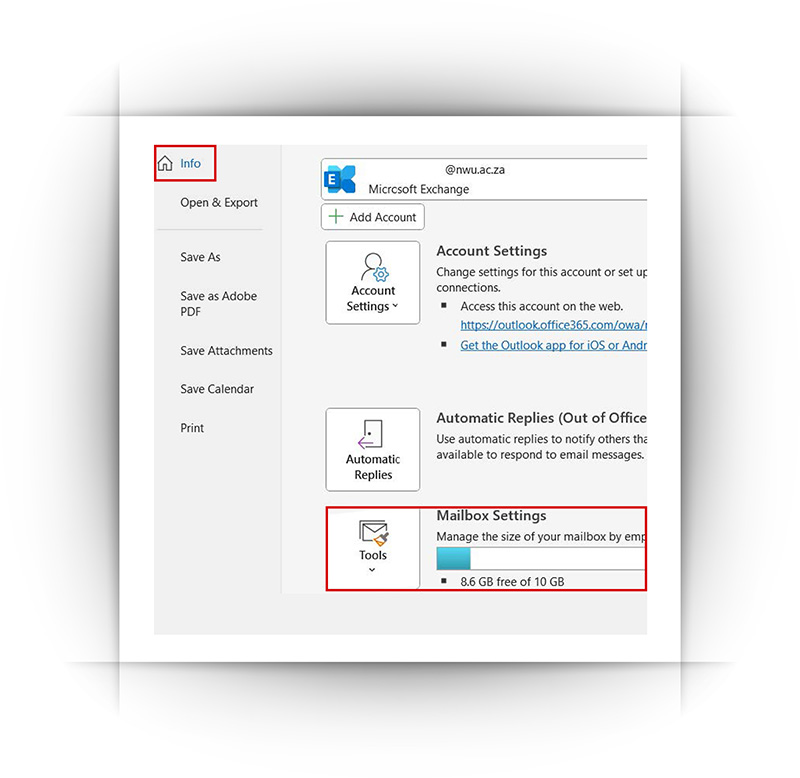
This mailbox has 8.6 GB of 10 GB.
Outlook Online Archive: What is the difference between my email Archive folder and Online Archive?
Online Archive (or In-Place Archive for webmail) is a Microsoft 365 feature that offers a place to store email to make room in your Inbox or to file older messages you don’t need to access readily. The Online Archive stores mail in a separate cloud mailbox instead of on your computer (.pst file).
What is the difference between my email Archive folder and Online Archive?
- The Archive folder is part of your primary mailbox and counts toward your overall storage limit. The Archive folder is beneficial because your email search results will include emails and attachments located here. Those results display more quickly compared to searching the Online Archive
- Email goes to this folder if you use the Outlook mobile app’s “swipe to archive” feature. To utilise the Online Archive, you must use the Outlook desktop app or Outlook through webmail.
- The Online Archive is a separate mailbox in your Outlook mail that adds 99 GB of storage. (In webmail, it’s called In-Place Archive.) This is a great place to move emails to de-clutter your primary mailbox, save space, or retain the information you don’t need to access as often. Messages in the Online Archive are still indexed and searchable when you click on the Online Archive section.
- A good rule to remember is to delete unwanted emails before archiving them into a different place to avoid unnecessary clutter that can make things harder to find later.

Moving Messages into the Online Archive
- Moving a single email
- You can drag and drop a message from your email folder (i.e., Inbox, Archive, etc.) directly into the Online Archive mailbox or right-click on the message and select Move → Online Archive), see infographic
- You can create folders in the Online Archive’s Archive to organize your messages, see inforgraphic.
- Moving multiple messages
- Move multiple messages in a row by holding down Shift and clicking the first message, then scroll down and click the last message you want to select. Outlook will select all the emails between those two. Then drag-and-drop or right-click to move them to the Online Archive.
- Move multiple messages in a row by holding down Shift and clicking the first message, then scroll down and click the last message you want to select. Outlook will select all the emails between those two. Then drag-and-drop or right-click to move them to the Online Archive.
- Moving an entire folder
- You can move an entire folder to the Online Archive by right-clicking and selecting Move Folder. Select the Online Archive mailbox as the destination.
Moving messages automatically to the Online Archive
Policies can be assigned to a specific folder from the Outlook web and the desktop version.
| Windows outlook Client Right-click your Inbox folder, select Properties Select the Policy tab Select the down-arrow at the Online Archive section and select the policy you want to apply to this folder. |
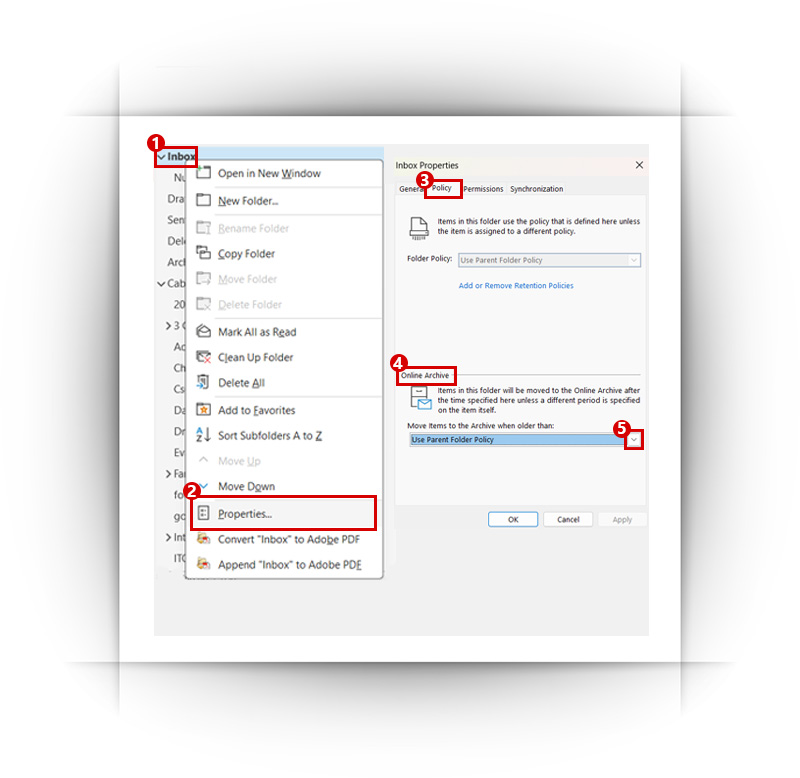
- Do the same process for the Sent folder or any other folders you wish to manage automatically.
The initial cleaning may take time as it slowly works through the backlog of emails.
Moving Messages out of the Online Archive
You can drag and drop emails from the Online Archive to another mailbox or folder or right-click and select Move (to your folder destination).
- The messages moved out of the Online Archive will count toward your Outlook storage again.
Personal backup of an Outlook Mailbox (certain date and time)
To back up an Outlook mailbox locally for personal preference (in addition to keeping them on the server), export the items to a .pst file that you can restore later as needed.
NOTE: If you choose to follow the .PST route, IT will not be held accountable for any data loss.
Notes:
- A .pst file, a “Personal” Outlook Data File, contains your messages and other Outlook items and can be saved locally.
- Don’t save .pst file to a synced drive like OneDrive or NextCloud. The .pst data will be corrupted.
- The NWU keeps a backup of an Outlook mailbox.
- Be aware that this feature is not available on the web and mobile versions.
Watch this Video for a quick overview:
https://www.youtube.com/watch?v=jMwUBE86a6k
To export a mailbox to a .pst file:
- Select File > Open & Export > Import/Export.
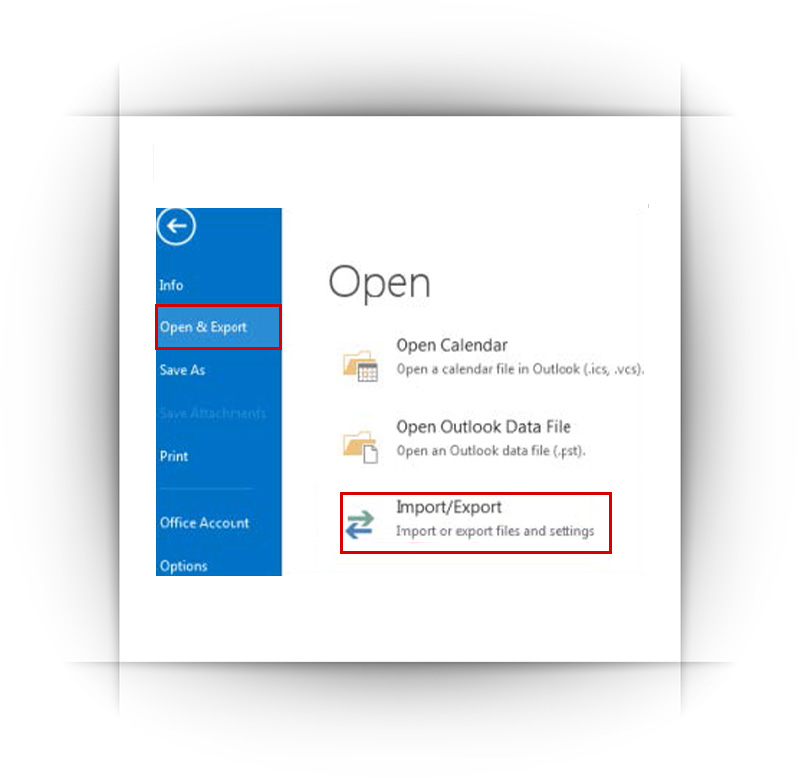
2. Select Export to a file, and then select Next.
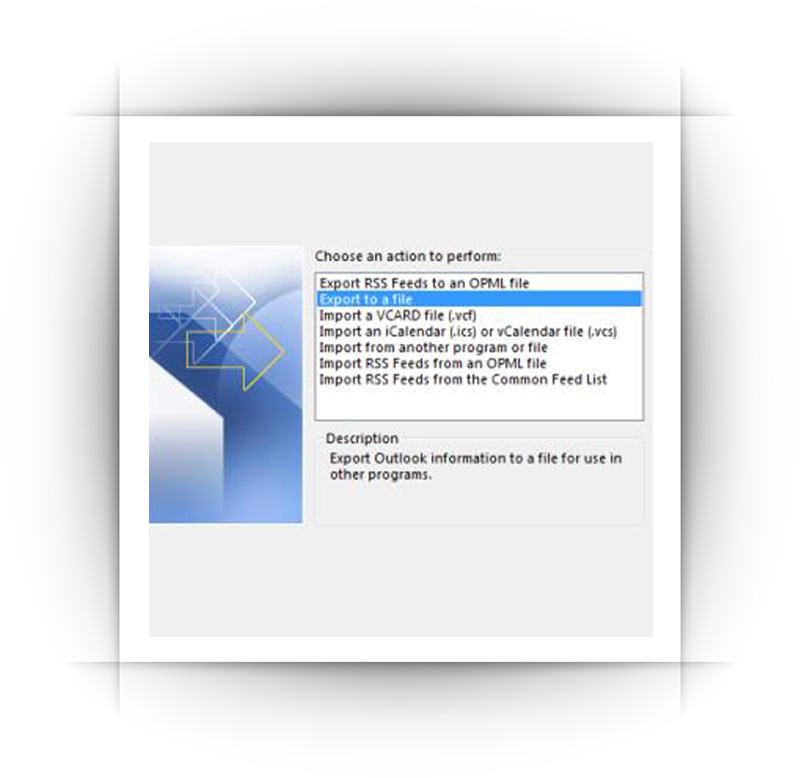
3. Select Outlook Data File (.pst), and select Next.
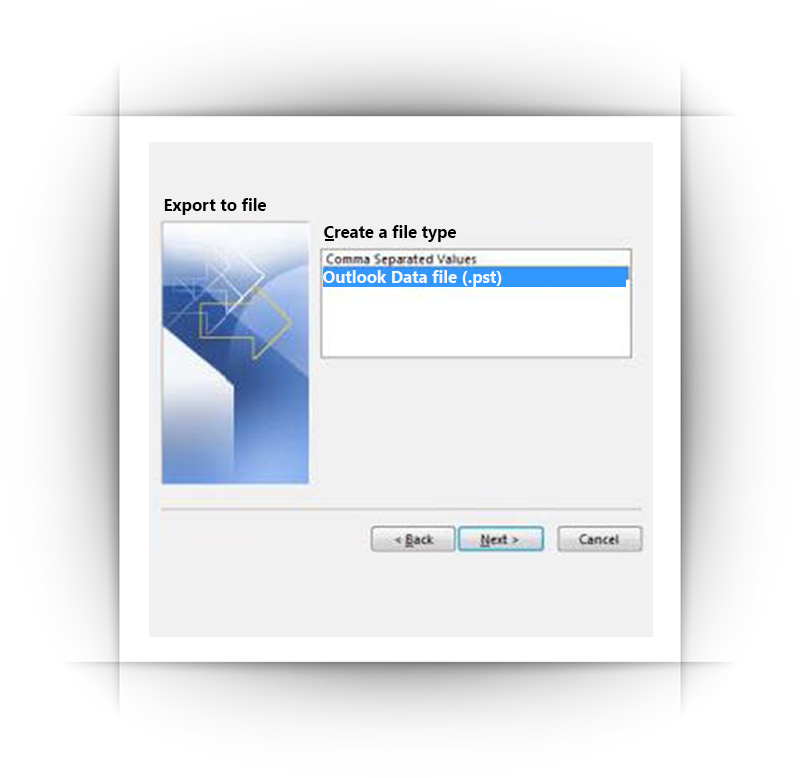
4. Select the mail folder/s you want to back up and select Next. Note: You can select only specific folders or the entire mailbox by selecting your email address (in this example click anne@consontoso.com)
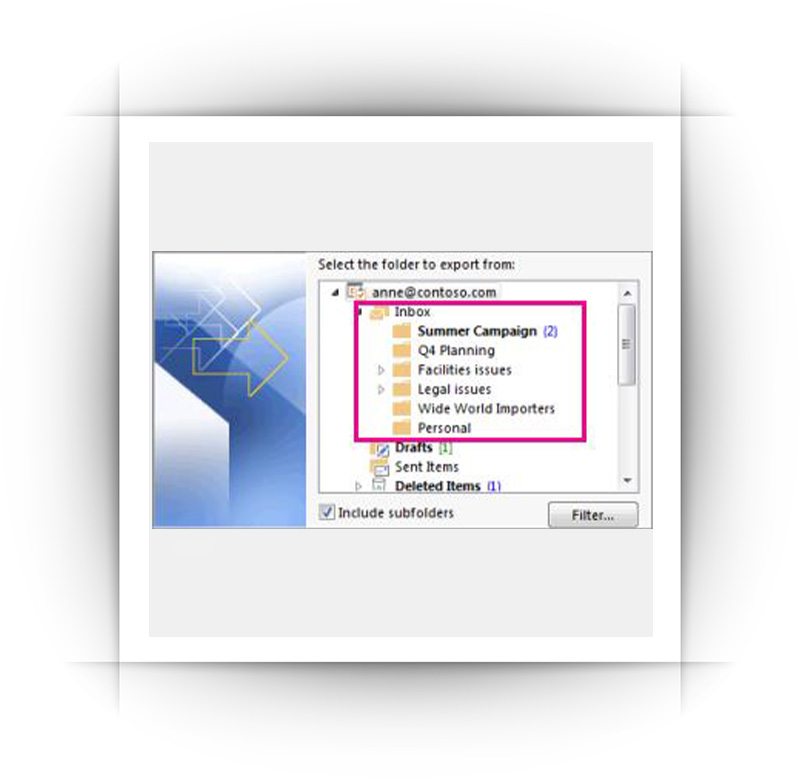
5. Choose a location and name for your backup file, and then select Finish.
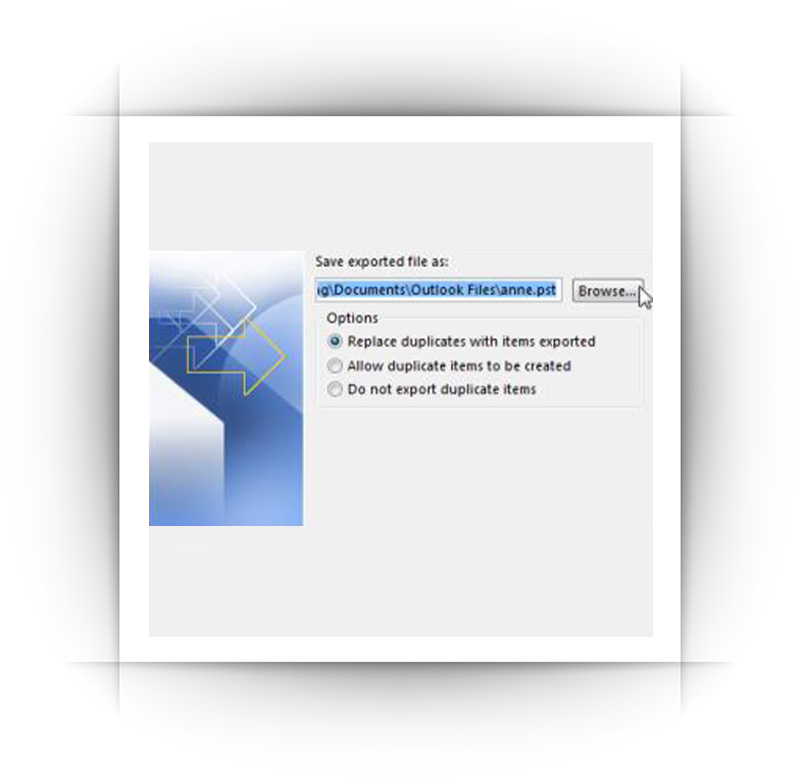
6. To ensure no one can access your files, enter and confirm a password and select OK.
Add and Drop a .pst Outlook data file to your mailbox
Select the default mailbox, for example Name.Surname@nwu.ac.ac
At the top of the Outlook ribbon, select File.
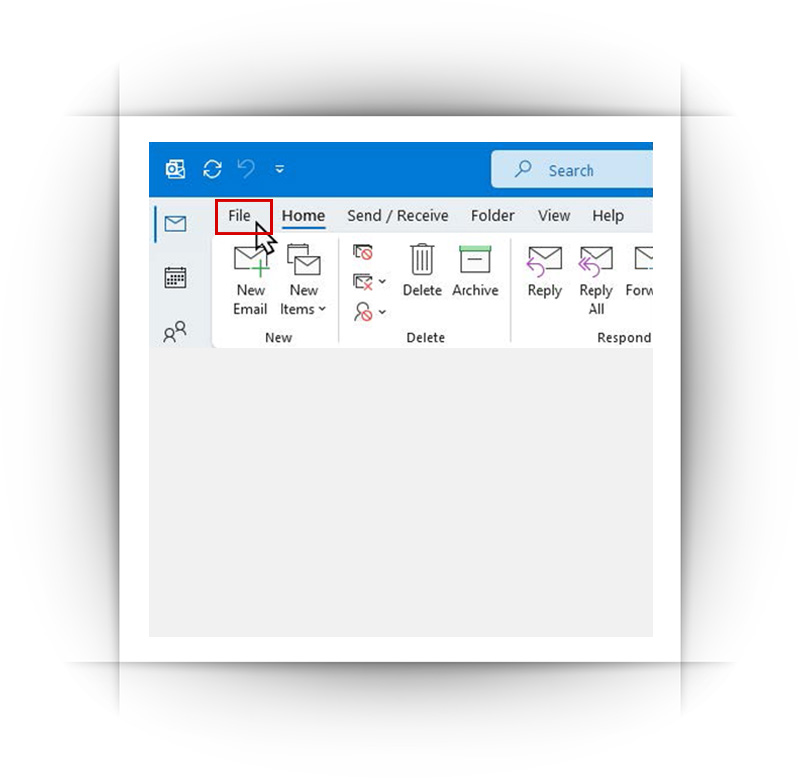
Select Open & Export > Open Outlook Data file.
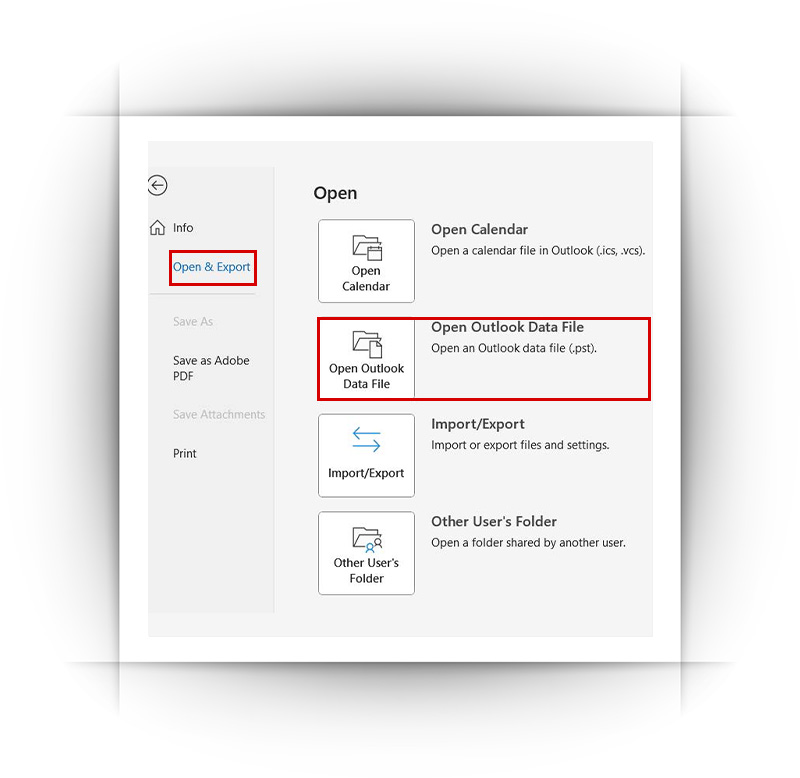
Browse to the .pst file you want to import. Select the .pst file and click Open.
If a password was assigned to the Outlook Data File (.pst), enter the password and then select OK.
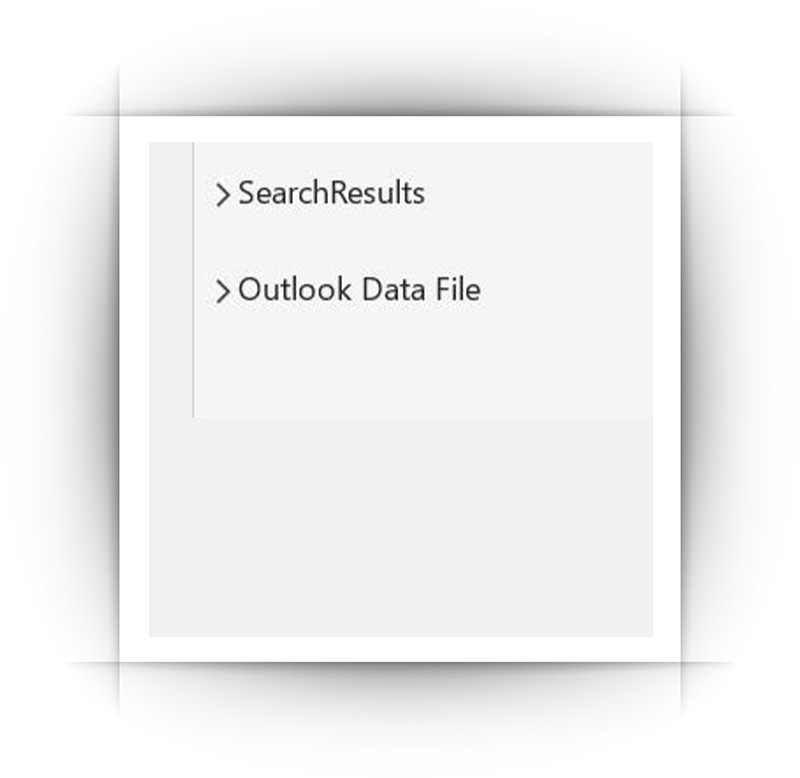
The Outlook Data File will be displayed in the left navigation.
Notes:
- Rename the Outlook Data file to a more descriptive name:
- Right-click on the Outlook Data File in the Navigation pane: Select Data File Properties Select Advanced Rename the Outlook Data File and click OK, OK.
